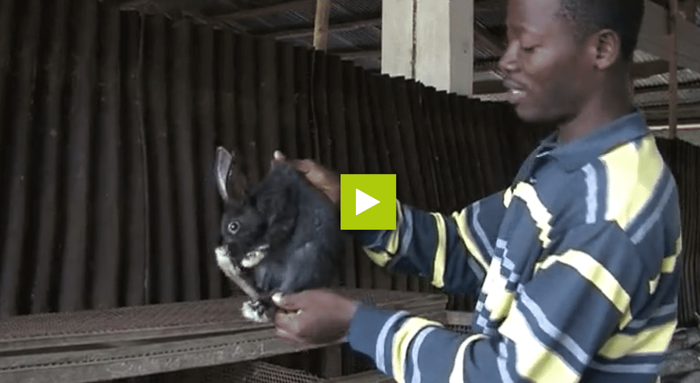Rabbits are very productive, a female rabbit can give birth to thirty babies in a year. Rabbit meat is tasty, high in protein and low in fat. Producers rear rabbits because it requires less space and time hence earning more money quickly.
To allow rabbits to grow well and multiply quickly, it is important to feed them well. For feeding rabbits in captivity you can use: Plants such as fresh tridax daisy, palm fronds and leaves from recently harvested groundnuts. Tubers and carrots leaves should be given to rabbits in sufficient quantities.
Disease prevention
Dry fodder should be given to rabbits to prevent diarrhea and bloating caused by parasites that are on wet fodder. Some fresh leaves from guava and pigeon pea help to treat diarrhea, neem and vernonia leaves help prevent coccidiosis. In dry seasons, leaves of groundnuts and beans left after harvest, can be used and stored at home in a dry place.
Risk of Scabies
Malnourished rabbits are more susceptible to scabies. A rabbit with scabies has scratches on the body, legs and ears and is frail. With scabies rabbits do not eat well, they grow slowly and have few babies. Therefore, their fodder should be complemented with concentrate feeds for energy, minerals, and vitamins.
Concentrate feeds can be made by mixing corn, wheat bran, roasted soya beans, oyster shell chopped cassava tubers and salt. Leaves of moringa help stimulate growth and are antibiotic.
Amount of feeds
250g to 300g of feed should be given to a female with babies, 120g to a pregnant female and 100g to a breeding male and 20g to 100g to small rabbits according to their age.
There should be a specific time to feed the rabbits everyday to reduces the stress upon the animal. The rabbits should have clean water all the time.
Eating troughs should heavy and fixed to the cage so that rabbit cannot step on it. Feeders holes are built in troughs for the young ones to eat through the bottom hole and mother rabbit the top hole to avoid spillage.



















